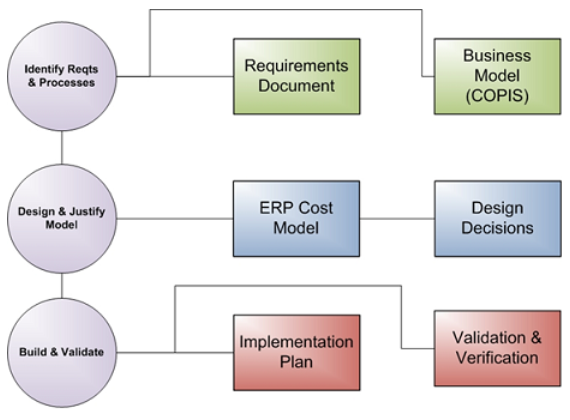|
1. Army Cost Framework Defined
The Army's Cost Framework (ACF) is a standard approach to defining both the enterprise Army's and each command's cost goals and metrics. ACF is a methodology with tools/templates used to define and document an organization's requirements, business processes, cost model and implementation plan. The process will help align costs to each organization's stated goals and allow senior leaders and analysts alike to review the effectiveness and efficiency of employed resources. A visual diagram of the process can be seen in Figure #1 below.
2. Components of the Army Cost Framework
The ACF includes processes and documentation artifacts to assist commands in defining their own cost framework.
- Scope & Requirements - The scope and requirements document clearly defines the cost objectives the command is trying to achieve. Any Army-wide or DoD-wide requirements should also be referenced in this document to ensure the resulting cost model can support external organization reporting requirements.
- COPIS Business Model - The COPIS business model is the heart of the process. The business model describes the key processes, products and services provided by the command. The business model also describes how these processes are generated by connecting the suppliers, inputs, outputs and customers to those processes. The business model serves as the foundation for all resulting documents including the cost model, implementation plan, and validation process.
- ERP Cost Model Blueprint - In order to measure and report on the cost objectives identified in the requirements document and mapped in the business model, the ERP accounting systems must be configured to capture the appropriate data.
- Design Rationale - There are often multiple approaches to capturing data within ERP systems. Choices must be made based on accuracy, complexity, and maintenance costs of the resulting design. The design rationale articulates the choices that were made, the trade-offs considered, and the rationale behind each decision.
- Implementation Plan - The implementation plan describes how a command will build out its cost framework in the systems of record. Not all of the data envisioned in the business and cost model may be available at the completion of the initial cost framework. The implementation plan will describe how targeted data will be obtained and how a command will implement the cost framework within its organization.
- Verification and Validation - Cost objects must be built and organizations must be trained to implement the cost framework. The verification and validation document will describe how success will be defined and identify the reports necessary to verify that the cost framework is being implemented by the command.
|
|
Cost Framework Creation/Modification Process
To assist commands in the creation, and future modification, of their cost frameworks, DASA-CE has devised a workflow process to guide the development of the documents included in a command's cost framework. An overview of the workflow process can be seen in Figure 2 below. In addition, an online tool has been created to facilitate communication between each command, DASA-CE and any other stakeholders in a given cost framework. Since one purpose of creating cost frameworks is to ensure each CF is aligned with enterprise Army's goals, the workflow tool will help ensure similar commands coordinate their approach to common cost objectives.

|
|
Army's Cost Framework Basis
Why do we have an Army Cost Framework? Each command has been responsible for defining and implementing its own cost model and reporting systems. The legacy cost and accounting systems were not capable of implementing full cost management. When the Army deployed its ERP systems to the field, many commands were not in a position to redefine and implement sophisticated cost management processes prior to the transition to the ERPs. Now that the Army has the tools and capabilities to fully support cost management at each command, DASA-CE is coordinating the cost management policies across the Army. The resulting cost frameworks will allow the Army to implement cost management to better align resources and improve the effectiveness of each dollar of funding.
-
Commands have different goals but the same requirements to measure efficiency and cost
All commands have goals and desired outcomes that should be defined. The ACF is an attempt to have both enterprise and command cost objectives defined using a consistent approach. Such an consistent approach increases corporate knowledge as personnel rotate between commands and allows costs across commands to be more easily compared and aggregated.
-
Army Cost Framework ensures alignments with Army goals
Commands currently track their own goals and prepare prescribed reports required by Congress, OSD and the Army HQ. As the Army-wide cost measures such as the Cost of a BCT or the Cost of Readiness are defined, it's critical that command-level costs can be accurately assigned and attributed to the Army-wide objectives. In fact, commands have often requested guidance on how to align their cost models with Army-wide reporting requirements. Providing a standard approach across all commands will allow Army-wide costs to be reported more efficiently.
-
Army Cost Framework ensures ERPs are used efficiently
The SAP-based ERP systems have powerful features that allow costs to be tracked and managed more granularly and more efficiently than the old accounting systems like STANFINS and SOMARDS. Commands must understand how best to use the ERPs to generate the information they need. DASA-CE can assist the commands in devising/updating their cost models to take advantage of the ERPs' capabilities. Command cost models need to be consistent to ensure long-term success of the Army's cost model. Having a single process to review Cost Management models across commands facilitates that goal.
|